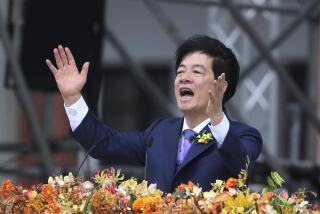Taiwanese Protest China Missile Move
- Share via
TAIPEI, Taiwan — More than 1 million Taiwanese formed a 300-mile-long human chain Saturday to protest China’s deployment of ballistic missiles along the mainland coast opposite the island.
The chain, organized by backers of Taiwanese President Chen Shui-bian’s reelection campaign, marked the largest political demonstration in the island’s history. Under sunny skies, most participants sported green -- the color associated with Chen’s Democratic Progressive Party -- either on flags or T-shirts.
Chen, seeking a second term in the March 20 election, is locked in an extremely tight race against his Nationalist Party opponent, Lien Chan, who advocates closer ties with mainland China. A poll released Friday by the cable television station TVBS showed that Chen had cut Lien’s lead from double digits to 3 percentage points, with many voters still undecided.
The string of humanity, in most cases made up of families and groups of friends, ran almost the entire length of the island, from the city of Keelung in the north through the capital, Taipei, and along the western coastal flatlands to Pingtung County at the island’s southernmost tip. Organizers said 2 million people took part, although other estimates put the number between 1.2 million and 1.5 million.
Addressing a rally in the western county of Miaoli, Chen called the human chain “a solemn gesture of holding hands to form a democratic Great Wall.”
“This will send a clear message to the world,” he said. “We love Taiwan. We want peace.”
Speaking at the same rally, former Taiwanese President Lee Teng-hui said the demonstration “underscores our refusal of Beijing’s unification proposal.” One protester in Taipei carried a burned mainland Chinese flag.
In addition to its strong anti-Beijing flavor, the event also was a reaffirmation of a separate Taiwanese identity. That is an unsettling idea to the mainland government, which insists that Taiwan is a breakaway Chinese province that must be reunited under its control, by force if necessary. The island has enjoyed de facto independence since the late 1940s when Nationalist leader Chiang Kai-shek retreated here with his armies from the mainland after being defeated by the Communists.
Saturday’s demonstration also marked the latest in a series of eye-catching, campaign maneuvers to which Chen has resorted in recent months to close in on his less flamboyant opponent. Just days after Taiwan’s parliament passed a watered-down version of the island’s first referendum law, Chen used a narrowly defined provision in the legislation to put two questions on the Chinese missiles to voters on election day.
At the time, the decision to hold a referendum was criticized by many world leaders, including President Bush, who feared that it could provoke Beijing and damage a decades-old status quo between China and Taiwan.
Because the missile buildup had been going on gradually for several years, Chen’s critics questioned the timing of the referendum, accusing him of making a reckless attempt to gain votes at the risk of diminishing the island’s security.
Organizers of the human chain said they got the idea from a similar 1989 event staged in Latvia, Lithuania and Estonia. In that demonstration, about 1 million people in the Baltic states linked hands in protest against Soviet rule.
On Saturday, many chanted pro-Taiwan slogans, while others expressed similar sentiments more quietly. Lan Shu-fen said she had come to the protest alone “to guard Taiwan by holding hands.” Like most of those who turned out, she said she planned to vote for Chen.
Chen Lin Chiau-chih, 81, said she joined the chain in Taipei, along with five of her children and grandchildren, because she was angry about the Chinese missile deployment.
“How can we remain silent?” she asked.
*
Times staff writer Marshall reported from Hong Kong and special correspondent Tsai reported from Taipei.
More to Read
Sign up for Essential California
The most important California stories and recommendations in your inbox every morning.
You may occasionally receive promotional content from the Los Angeles Times.










